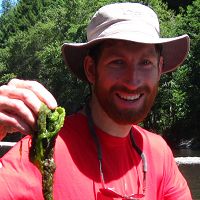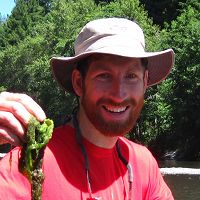Critical Zone Profile - KEITH BOUMA-GREGSON (freshwater ecologist, PhD student)
Keith Bouma-Gregson is a river ecologist studying algae in the Eel River, located in the Coast Range Mountains of Northern California. Algae are foundational to the summertime food web. Insects and fish feed on the high algal productivity that the river supports. However, some algae negatively affect the river ecosystem. Cyanobacteria, or blue-green algae, can produce toxins which are harmful to humans, pets, and livestock. Bouma-Gregson is researching the ecology of cyanobacterial mats. He and his colleagues are studying whether drought and low-flow conditions promote the growth of cyanobacteria over other non-toxic algae. The goal of this research is to better predict when and where cyanobacterial mats will occur, and then inform river management to reduce the frequency of these mats.
“I like the mystery of aquatic systems and algae. The action is under the surface and difficult to see, so you need either a snorkel or a microscope. I like peering into a world most people don’t notice.” – Keith Bouma-Gregson
I grew up in Southern California. My interest in ecology developed from family camping trips throughout the state, but especially in the Sierra Nevada. Living in the arid Southern California suburbs, when we went camping I loved playing in the creeks and rivers filled by snowmelt from the Sierra peaks. In college I began to learn more about California’s “hydraulic” society and the way we move water hundreds of miles and across watershed boundaries to bring it to people and farms. I think this realization compelled me to transform a love of hiking and backpacking near water into a commitment to study this vital resource.
When it rains, most of the water passes through the critical zone before entering river channels, wetlands, and lakes. The processes that occur in the critical zone are crucial for maintaining abundant clean water for aquatic organisms to live in. In many watersheds algae form the base of the aquatic food web. Understanding how changes in algal species affect aquatic food webs is important to conserve and sustain aquatic habitats for people and animals. For instance, cyanobacterial mats produce toxins and degrade aquatic habitats. We need to understand the environmental drivers of these mats, in order to keep California’s rivers safe for visitors and swimmers.
I suspect that interactions between warm temperature, low flow, and high nutrients are driving cyanobacterial growth. I will be conducting field experiments at the Eel River CZO site to learn how different algal species respond to various nutrient and temperature regimes. It is challenging and exciting to be on the edge of an environmental problem, waiting to see which of our hypotheses the experimental data will support.
As a freshwater ecologist, my work intersects ecology, environmental management, and public health. The CZO network has linked me to terrestrial ecologists, hydrologists, and geologists as we seek to understand the ecological consequences of critical zone processes for aquatic ecosystems.
If people could get captivated by the critical zone, we would see its priority increase.
This could happen by developing connections between the animals and places that people have affections for with the critical zone processes that support these organisms or landscapes. For instance, if salmon could be linked to tree roots, people could then learn how evapotranspiration affects the water in tributaries that salmon inhabit.
For me it was a big “aha” moment when I realized the importance of sub-surface processes in controlling the dynamics of surface waters. I think in our culture we under-appreciate the connections between ground and surface waters. In California we are only just beginning to manage and track groundwater pumping. We need to better understand critical zone processes in order to maintain abundant, clean surface waters, especially in arid climates, such as those in the Western U.S.
The Eel River Watershed was heavily logged throughout the 20th Century. There are now many areas with stands of young trees that are all the same age. Such young forests are thirstier than old forests. As California experiences prolonged drought, residents are recognizing how forests can affect the water levels in springs, wells, and river channels. The Eel River Recovery Project, a local environmental non-profit, has been working to promote forest health as a way of maintaining freshwater resources. I have been collaborating with this group to conduct algal outreach seminars and help educate local citizens about algal ecology and cyanobacterial toxins in the Eel River watershed. Learn more at: http://www.eelriverrecovery.org
:: By Linda Copman, staff writer ::
Keith Bouma-Gregson.
Conducting an algal education workshop with the Eel River Recovery Project in June 2014.
News Category:
RESEARCH |
PEOPLE |
EDUCATION/OUTREACH
Related News
Explore Further







